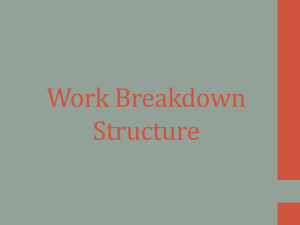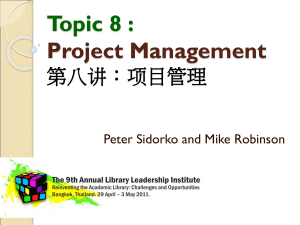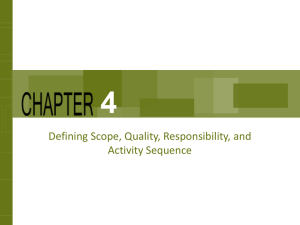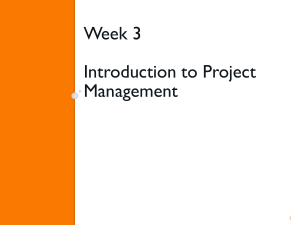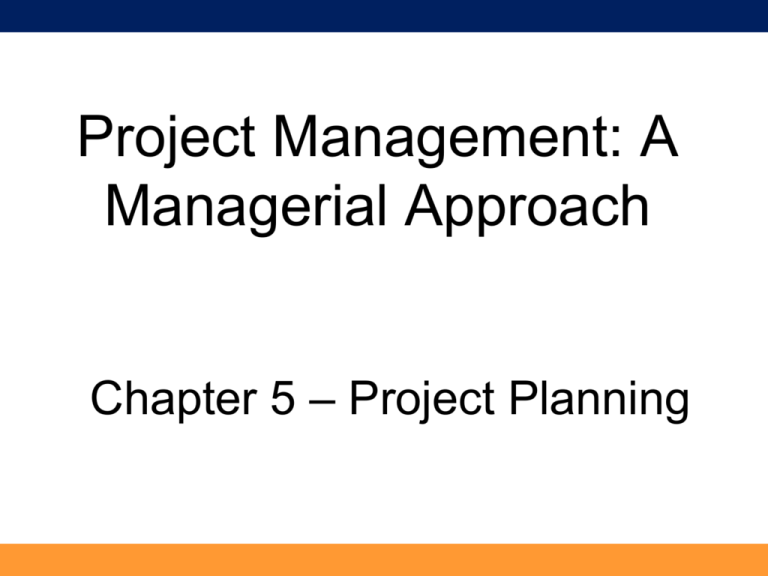
Project Management: A
Managerial Approach
Chapter 5 – Project Planning
Overview
This chapter deals with:
• Project Planning and its nature
• What should be in a project plan
• What needs to be in your project proposal.
21-1
Project Planning
• Most teams already had their kick-off meetings.
• You know what company wants, so you will be
able to define your goals and objectives.
• Once these are known, you also need to define
the scope and other elements.
31-1
Project Planning
Project Planning helps you decide:
• exactly what to do, who will do it, with what.
• WBS (work breakdown structure): a simple list of all project
activities with major ones broken down into sub-activities. It is
part of its action plan.
• Project’s linear responsibility chart (or table): a specialized view
of the action plan and focuses on who has what responsibility
(performing, approving, communicating, supporting, etc.)
associated with each project task.
41-1
Project Planning
• When people give you money, they expect for you to
know what to do, when to do and so on, since the risk
is very high.
• They will need to know if your cost is reasonable, if
your approach is feasible, if your schedule is feasible.
• Plan reflects the quality of your work, reputation and
preparation for this kind of work, that’s how important
the project plan is.
51-1
Initial Project Coordination
• The project launch meeting (kick-off meeting).
– called by a senior manager or by the project manager, when
available.
• Routine vs. unique projects:
– the routine ones are only for touching base purpose; while the
unique ones require discussion of details.
• Outcomes:
– (1) technical scope,
– (2) basic areas of performance responsibility accepted by
participants, and
– (3) tentative overall schedules and budgets.
61-1
The Project Plan
• The final approved result of this procedure is the project plan, also
known as a Master or Baseline plan
• Once planning phase is complete, it is beneficial to hold a postplanning review
• The major purpose of the review is to ensure that all necessary
elements of a project plan have been properly developed and
communicated
71-1
Project Plan Elements
1.
2.
3.
4.
5.
6.
7.
8.
9.
10.
11.
Executive summary
Introduction / Overview
Problem Statement, Goals and Objectives
General approach
Contractual aspects.
Schedules
Resources
Personnel
Budget
Evaluation methods
Potential problems
81-1
Project Plan Elements
Executive Summary (not numbered)
• A short summary of project’s major objective
and scope, its relationship to the firm’s goal (or
objectives), its managerial structure, and major
milestones in its schedule.
• 1 page ideal – 2 pages max!
• Take the one or two more important sentences
from each section, tie them together logically,
and tell the story of your proposal.
91-1
Project Plan Elements
2. Introduction / Overview
–
–
–
–
Company Background
Mission Statement (*)
Vision Statement (*)
Problem Background:
•
•
It should lead to problem statement.
Provide only relevant problem background.
(*) obtain from company
101-1
Project Plan Elements
3. Problem Statement
Goals / Objectives
•
Goals emphasize the importance of your project.
–
•
They are not necessarily something you will accomplish at the end of
your project.
In line with those goals, objectives are a step towards those
goals.
–
These objectives will be delivered in the project. Think in term of
tangible deliverables. They must be solid, tangible, measurable.
–
This is what you will get and deliver at the end of the project.
–
You and the client must agree on these deliverables.
–
They must make sense. Otherwise… rejection.
111-1
Project Plan Elements
3. Problem Statement
Goals and Objectives
•
If unclear, they may become arguable at the end.
•
If you don’t know or define the deliverables, the results will be hard to
measure.
–
Once defined, you will objectively be able to develop a performance
measurement criteria to measure the quality for the deliverables.
–
When we check the results, these make sure they are within your domain, and
will avoid controversy and ambiguity at the end.
121-1
Project Plan Elements
3. Problem Statement, Goals and Objectives
Scope
–
–
–
Scope is the boundary (domain) of the problem (or
system) to take on.
Define the field you will cover in your problem.
For instance, what departments will you analyze,
what processes will not be included in the study,
etc.
131-1
Project Plan Elements
3. Problem Statement, Goals and Objectives
Constraints - Assumptions
–
–
–
Assumptions and constraints limit and confine the validity
and applicability of the proposed solution.
Assumptions will be general in nature, however you should
include specific ones if you know they will apply and help
further delimit your scope.
Constraints are more specific i.e. “no internal walls will be
torn down in the redesign of the facility…”
141-1
Project Plan Elements
3. Problem Statement, Goals and Objectives
Scope, Constraints, Assumptions and Merit
–
–
When we check the results, these make sure they
are within your domain, and will avoid
controversy and ambiguity at the end.
Be specific in your terms so there are no
misunderstandings, so that you don’t have to go to
court, which is the last thing you want to do.
151-1
Project Plan Elements
3. Problem Statement, Goals and Objectives
–
–
–
Merit
This is an objective justification of the project for getting
closer to the goals, in alignment with the company mission
and vision.
Underlines the importance of the project and why it should
be executed.
It should be quantifiable in terms of cost/benefit, cost
savings, profit, quality improvement, response time
shortening, and/or other benefit due to the project once its
objective is reached.
161-1
Project Plan Elements
4. General approach
Some terms and ideas that could be included in
general technical approach:
•
•
•
•
•
•
•
•
•
•
Concept evaluation
Requirements identification
Design
Methodology
Implementation
Test
Integration
Customer test and evaluation
Validation
Operations and maintenance
171-1
Project Plan Elements
4. General approach
–
–
the managerial and technical approaches to the work.
Tells how will objectives be accomplished, the
solution approach to certain level of detail.
•
•
–
–
includes WBS and description
managerial structure.
In the proposal, it is possible you don’t have the WBS
fully defined
You should have it to a certain level, so the approach
is technically feasible and demonstrates you have the
technical expertise.
181-1
Project Plan Elements
4. Work Breakdown Structure (WBS)
• Also known as “Hierarchical (or Even) planning
system.
• Is an approach to master project planning
(development of the action plan).
• This is also called MPS (master project
planning). The end is the Master Project Plan
• It does not have all the details, but includes the
major components (what are the tasks, who will
do them, resources required, timing/duration,
etc.)
191-1
Project Plan Elements
4. Work Breakdown Structure (WBS)
• It is called even planning because when you
plan, you go through layers downward, level by
level, so you break the top layer into several
components of work.
•
Then you move down to the next layer to
identify the tasks, in an even handed manner,
and so on.
201-1
Project Plan Elements
4. Work Breakdown Structure (WBS)
•
At this point, you don’t know all the details of the work,
the size of them, etc..
•
However, you will break it down in some natural way so
it becomes smaller, more manageable, assignable in
terms of people, budget, two or three layers.
•
You will not complete the entire work decomposition at
this stage either, nor as one chunk of work. So it will be
something in between.
211-1
Project Planning
221-1
Project Plan Elements
4. Work Breakdown Structure (WBS)
•
•
•
Once proposal is approved, you will start with initial
WBS, which have been OKd, so you further develop or
make changes.
Maybe there are changes, requirements, personnel, so
you can make adjustments and further decompose into
more specific work.
In the final proposal, each layer should be about 3-7
elements max, particularly if it is manually managed
(you can only manage 7 people, 2 is two little).
231-1
Project Plan Elements
4. General Approach (continued):
–
–
–
–
–
The Linear Responsibility Chart
indicates, for each task, who is responsible for what.
(Fig. 5-7) See legend.
Identify all possible roles, then for each task you
identify who will play which role.
It is called linear because you are not assigning
sequence, just assigning roles.
If you don’t need to have notification, approval, you
simply assign the job linearly. Sets up people as a
resource Responsible: actually does the work.
241-1
WBS Linear Responsibility Chart
251-1
Simplified Linear Responsibility Chart
261-1
Project Plan Elements
5. Contractual aspects
• There may be considerable outsourced work
–
–
–
–
–
who are the subs / entire chain of command down to
your suppliers and vendors
how do you assure quality and timely delivery
Vendor qualification
how do you enforce / protect contracts / how do you
manage risk.
In your case, you have a small project, you will do
everything yourself, so in your proposal you will say
“There are no contractual issues in the project.”
271-1
Project Plan Elements
5. Contractual aspects
–
–
–
–
–
–
–
–
–
–
All reporting requirements*
customer-supplied resources*
liaison arrangements*
advisory committees
project review and cancellation procedures*
proprietary requirements*
Confidentiality agreements*
use of subcontractors
deliverables and their specs*
procedures for changes*
281-1
Project Plan Elements
6. Schedules
–
You will need to supply the PROJECT MASTER
SCHEDULE based on Master Project Plan (Fig. 510), which include the major project breakdown,
without details.
–
In detailed schedule you can go by days, or hours.
Use the symbols to indicate milestones. These are
project major tasks.
–
Summarizes your project plan.
291-1
Project Plan Elements
6. Schedules
–
–
–
Microsoft Project is a good tool to use.
Include major task/subtask schedule (not
detailed) and milestone events.
Although you don’t have entire detailed
breakdown, you have done so into major
phases and down to the next level or two.
You should also include major milestones in
the schedule.
301-1
Project Master Schedule
311-1
Project Plan Elements
6. Schedules
–
–
–
No matter how small the contract is, you
don’t get the money upfront or all in one
payment. You get it in installments.
So progress and payment will be based on
meeting certain milestones (technical, quality
checks, deliverables, payments).
Contracts can get cancelled if they don’t pass
the review. I.e. General Design (Conceptual)
- Pass? Proceed to Detailed Design.
321-1
Project Plan Elements
7. Resources
–
Includes special resource requirements (equipment,
tools, software, other).
–
Start with the WBS, so you will know the resources
required, expertise required, maybe security clearance
required, and cost.
331-1
Project Plan Elements
8. Personnel: personnel requirements, special skills
and security clearance.
–
–
–
–
Maybe you don’t have a specific person or firm
selected for that task
So set up your organizational structure by expertise or
job function.
Accompany it with a brief job description, so you know
what kind of expertise is required to do the job.
Then you can go out and hire the people. That should
be the professional approach.
341-1
Project Plan Elements
9. Budget
–
–
–
–
At least, you should come up with a sensible cost.
Based on WBS, estimate direct costs by task, adding
labor and resources. No indirect cost or profit is
assumed in this case.
In the budget table you can have a column saying
who absorbs the costs (students, FIU, company). In
executive summary, after including total cost, say
“these costs are absorbed by FIU”.
This sends a message that looks good, is honest, you
are saying this is not free, this is how much it would
cost you otherwise.
351-1
Project Plan Elements
10. Evaluation methods
So how do you defend yourself if the company
says the deliverable you provided is not what
they wanted?
• This is something you agree on (a tool, method
or scale) to evaluate the quality of your
deliverable.
• It should be agreed upon, so rules will not be
changed at the last moment; it will be difficult if
you disagree on the measurement of the
deliverable.
361-1
Project Plan Elements
10. Evaluation methods
–
–
–
–
–
Devise checklist or weighed measurement matrix to
measure accomplishment of our objective.
Each objective will have deliverable(s) and each in
turn it will have an evaluation method.
You can go back to the evaluation methods, check
each deliverable, get approval and projects get
accepted.
This is very important for non-bid contracts.
Bid projects have specs clearly defined in the bid
contract.
371-1
Project Plan Elements
11. Potential problems
–
–
–
–
These are potential problems that may arise.
Anticipated potential difficulties (technical
failure, strikes, weather, type deadlines,
subcontractor defaults, etc.)
You identify risks, assess potential outcomes
should they occur, how you plan to track
those risks.
If there is no risks, you say “there are no risks
associated with this project.”
381-1
Role of the PM: System Integration
• As an integrator, the PM will evaluate:
– Performance - what a system does
– Effectiveness - achieve desired performance in an
optimal manner
• Requires no component specifications unless necessary
to meet one or more systems requirements
• Every component requirement should be traceable to
one or more systems requirements
• Design components to optimize system performance,
not the performance of subsystems
– Cost Systems - cost is a design parameter
391-1
Copyright 2006 John Wiley & Sons, Inc.
All rights reserved. Reproduction or translation of this work beyond that permitted in section 117
of the 1976 United States Copyright Act without express permission of the copyright owner is
unlawful. Request for further information should be addressed to the Permissions Department,
John Wiley & Sons, Inc. The Publisher assumes no responsibility for errors, omissions, or
damages caused by the use of these programs or from the use of the information herein.
401-1




